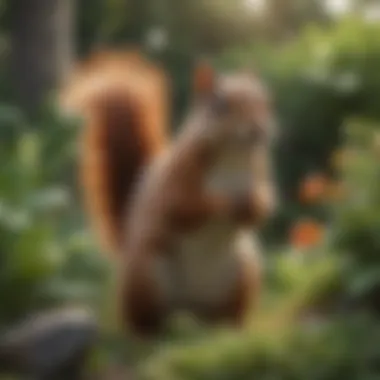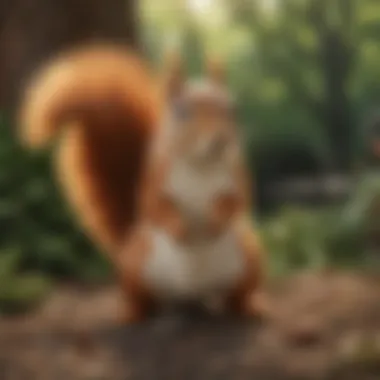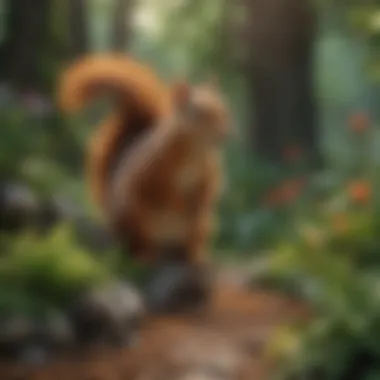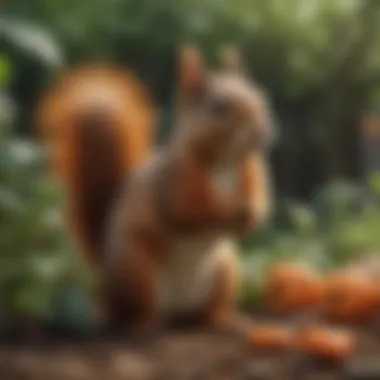Humane Ways to Manage Squirrel Overpopulation in Yards


Intro
Squirrel overpopulation poses a unique challenge for many homeowners. In recent years, the increased presence of squirrels has created concerns, particularly regarding the impact on gardens and landscaping. Understanding the ecological role of squirrels is crucial for managing their numbers in an effective and humane way. This article will provide a comprehensive guide on how to address squirrel overpopulation while protecting your garden from potential damage.
Key Insights and Trends
Factors Contributing to Increased Squirrel Populations
The rise in squirrel populations can be attributed to several factors. Urbanization has led to a loss of natural predators, allowing squirrel numbers to flourish. Additionally, human activities leave behind abundant food sources, such as bird feeders, trash, and garden fruits, which attract squirrels. As a result, many homeowners find themselves grappling with the consequences of squirrel overpopulation.
Ecological Role of Squirrels
Squirrels play a significant ecological role, including seed dispersion and acting as prey for various predators. Understanding their contributions to the environment can help homeowners appreciate their presence while seeking effective management strategies.
Practical Tips and How-To Guides
Implementing Humane Deterrents
When it comes to managing squirrel populations, humane methods are essential. Homeowners can consider these approaches:
- Physical Barriers: Installing fencing around gardens can deter squirrels from entering.
- Repellents: Utilizing cayenne pepper or commercial squirrel repellents can make areas less appealing.
- Decoys: Fake owls or predator sounds can discourage squirrels from frequenting your yard.
Securing Food Sources
To minimize squirrel attraction, it is important to secure any food sources. Consider these strategies:
- Bird Feeders: Use squirrel-proof feeders to prevent squirrels from accessing birdseed.
- Compost Bins: Keep compost bins tightly closed to avoid attracting them with food scraps.
- Trash: Ensure trash cans are sealed tightly to eliminate easy access to food waste.
Maintaining a Balanced Ecosystem
Encouraging natural predators can also help manage the squirrel populations. If local regulations allow, consider creating habitats for birds of prey or other natural predators, as they can help control the squirrel numbers.
"Managing wildlife populations requires a thoughtful and balanced approach to ensure coexistence." - Wildlife Management Expert
By applying these humane methods and understanding the underlying factors of squirrel overpopulation, homeowners can protect their gardens and maintain a balanced ecosystem in their yards.
Prologue to Squirrel Overpopulation
Squirrel overpopulation is a pressing issue that confronts many homeowners across various urban and suburban landscapes. This topic is not just an abstract concern; it directly influences the well-being of your yard and garden. Understanding the dynamics of squirrel populations can help homeowners recognize the impact these creatures have on landscaping choices and gardening efforts.
Understanding the Squirrel Population Dynamics
Squirrels belong to the rodent family, and their behaviors are notably affected by factors like habitat availability, food sources, and environmental conditions. They reproduce quickly, often having multiple litters each year. Their adaptability to different environments makes them thrive, particularly in residential areas. When conditions are favorable, squirrel populations can increase rapidly, leading to significant overpopulation in local areas. This outcome can have serious implications for outdoor spaces, including damaged plants and increased competition for resources among local wildlife.
Many species of squirrels exist, but the Eastern Gray Squirrel is one of the most commonly seen in North America. It typically prefers wooded areas but has increasingly moved into urban settings, where food is abundant and their natural predators are scarce. Homeowners should be aware of these dynamics to better manage their yards and gardens.
The Increasing Presence of Squirrels in Urban Settings
The urbanization trend has led to more squirrels inhabiting residential areas. Cities and suburbs provide numerous food resources, not just from natural plants but also from human activity. Bird feeders, gardens, and unsecured trash attract squirrels, encouraging their populations to flourish.
As more green spaces are converted into urban developments, squirrels find refuge in parks, yards, and gardens. The removal of their natural habitats forces these animals to seek alternative environments. The interaction between squirrels and homeowners can lead to a range of concerns, from aesthetic damage to gardens to health worries, such as the potential spread of diseases.


In summary, the increasing presence of squirrels in urban settings symbolizes a larger conversation about wildlife management. Homeowners must understand not just the ecological implications, but also how to coexist with local fauna responsibly and humanely.
Ecological Role of Squirrels
Squirrels play a significant role in the ecosystem. This aspect of their existence is often overlooked by homeowners who mainly see them as pests. Understanding their ecological role helps in recognizing the balance they maintain within nature.
By acknowledging the positive contributions of squirrels, homeowners can take a more informed approach in managing their populations. We should consider how their activities support plant life and overall biodiversity in our yards and communities.
Squirrels as Seed Dispersers
Squirrels are essential for the dispersal of seeds, which contributes to the growth of various plants and trees. When these animals forage, they often bury nuts and seeds as a food reserve for the winter months. However, not all these buried seeds are retrieved. This behavior leads to the germination of some seeds, promoting plant diversity. Research shows that many tree species, such as oak and pine, benefit from this method of seed dispersal.
- As squirrels hide seeds, they indirectly facilitate the establishment of new plants.
- This phenomenon helps maintain a healthy ecosystem, as diverse plant life supports a variety of wildlife.
- Without squirrels, certain plants might struggle to reproduce or expand their habitats.
Understanding this action highlights the interconnectedness of wildlife and plant health. The presence of squirrels in your yard is a reflection of a vibrant, functioning ecosystem, even if their overpopulation can create challenges.
Impact on Plant Growth
The impact of squirrels on plant growth can be both positive and negative. On one hand, their seed dispersal benefits the ecological landscape. On the other hand, squirrels can cause damage to sensitive plants and gardens.
- Positive Impacts: Squirrels contribute to flower and fruit production by aiding in pollination as they move through plants, among other things.
- Negative Impacts: They may also consume flower buds, fruits, and vegetables, which can be detrimental to home gardens. This behavior can lead to frustration for gardeners who see their hard work undermined.
In essence, while squirrels facilitate ecological processes, their overpopulation can lead to increased competition for resources, ultimately affecting the growth patterns of plants. Homeowners need to balance their yard’s ecological needs with practices that keep their gardens flourishing.
The Challenges of Squirrel Overpopulation
Squirrel overpopulation presents distinct challenges for homeowners and gardeners. As squirrel numbers rise, they can cause significant disruption in residential areas. Understanding these challenges is critical for those seeking to manage these lively creatures without compromising their yard's beauty.
Damage to Landscaping and Gardens
Squirrels are notorious for their ability to damage gardens and landscaping. They are known to dig up bulbs, consume fruits and nuts, and disrupt freshly planted seeds. Their foraging behaviors can quickly turn a flourishing garden into a barren patch.
- Root Damage: Squirrels may dig around the base of plants, leading to root disturbance. This action can compromise the health of the plant and limit its growth potential.
- Fruit Destruction: Many gardeners are frustrated when squirrels raiding trees and shrubs. They eat fruits like apples, berries, and nuts, which can be disheartening for homeowners who have nurtured these plants.
- Nesting Issues: Additionally, squirrels may choose to nest in unsecured garden sheds or attics, creating inconvenient situations that extend beyond mere landscaping damage.
In essence, the presence of an overabundant squirrel population can lead to not just aesthetic decline but also to increased maintenance efforts for homeowners.
Nuisance Behavior and Property Concerns
Beyond their effects on gardens, nuisance behaviors of squirrels become apparent, resulting in various property concerns. Squirrels are curious creatures, and their exploration can lead to anxiety for residents. When squirrels invade private spaces, they might become unwelcome guests.
- Noise and Disturbance: Squirrels are generally noisy. Frequent chattering, especially during mating season, can disrupt the peace in a backyard. This escalation in sound can disturb family activities and lead to frustration.
- Chewing and Gnawing: They often chew on wires, garden furniture, and other structures. This not only damages property but can also be hazardous, especially in areas with electrical components.
- Waste Issues: Squirrels leave waste in yards and gardens. This can attract other pests and create health concerns for pets and children.
To summarize, managing squirrel overpopulation is essential not just for maintaining an aesthetically pleasing garden but also for safeguarding properties against various nuisance issues. Strategies must be implemented to ensure a balanced coexistence while preserving the integrity of residential areas.
"The presence of squirrels can lead to both ecological benefits and challenges; thus, understanding their impact is crucial for effective management."
Properly addressing these challenges lays the foundation for further steps in managing their populations while fostering a harmonious living environment.
Factors Contributing to Squirrel Overpopulation
Understanding the driving forces behind squirrel overpopulation is key in managing their presence in residential areas. Several interconnected factors contribute to the increase in squirrel populations, particularly in urban settings. By identifying and addressing these factors, homeowners can create environments that are less conducive to increased squirrel activity.
Urbanization and Habitat Expansion


Urbanization plays a significant role in squirrel overpopulation. As cities and suburbs expand, they encroach on natural habitats, displacing indigenous wildlife. Squirrels are highly adaptable creatures. They can thrive in hybrid environments created by urban development.
In the quest for survival, squirrels find new nesting locations in attics, trees, and parks. This adaptation allows them to flourish in areas they previously would not have inhabited. Moreover, more green spaces such as parks and gardens are incorporated into city planning. This increase in available area for nesting leads to higher densities of squirrels.
Availability of Food Sources
Another major contributor is the availability of food sources. Urban settings often present abundant food supplies, from discarded food in trash cans to bird feeders that attract squirrels. Homeowners may unintentionally provide sustenance through unprotected gardens or open compost bins.
In addition, commercial establishments, such as restaurants and grocery stores, often result in easy pickings for squirrels. Their opportunistic nature allows them to exploit these resources efficiently. When food is plentiful and accessible, squirrel populations can grow rapidly. This availability creates a cycle where increased population results in greater competition for food. As a result, reproductive rates rise, leading to a further increase in their numbers.
A detailed understanding of these factors can help mitigate the impact of squirrel overpopulation. By implementing strategies that address the urban environment and limiting food availability, homeowners can contribute to a more balanced coexistence with these creatures.
Humane Deterrent Strategies
Managing squirrel overpopulation requires thoughtful and humane strategies. It is essential to consider methods that do not inflict harm on these creatures while effectively reducing their numbers in your yard. Many homeowners desire to protect their gardens and landscapes without resorting to lethal measures. Understanding how to coexist with these animals is a vital part of wildlife management. These humane deterrent strategies will allow you to keep your garden vibrant while minimizing squirrel intrusion.
Behavioral Modifications of Squirrels
Changing the behavior of squirrels is a subtle yet effective way to deter them. Squirrels are intelligent animals. They can quickly learn the habits of their environment. By fostering an environment that discourages them, you can reduce their presence over time. For instance, avoid leaving food sources accessible. This practice involves not only pet food but also birdseed and garden produce. If a squirrel realizes there is no consistent food supply, it will likely explore other areas.
Other tactics include using sound deterrents. Devices like motion-activated sprinklers can scare them away with sudden bursts of water. Moreover, making loud noises or utilizing certain sounds can irritate squirrels enough to make them choose different spots. It is all about altering their routines.
Physical Barriers and Repellents
Creating physical barriers can enhance your deterrent strategy. Fencing off garden areas with barriers can prevent squirrels from accessing your plants. Use a fence made from materials that squirrels find challenging to climb. Consider fencing that is at least five feet tall and angled outward at the top. This design takes advantage of their natural behaviors and keeps them from jumping over.
In addition to barriers, repellents, both natural and synthetic, can assist in keeping squirrels at bay. Some people find success with commercial squirrel repellents. Alternatively, homemade concoctions using ingredients such as cayenne pepper or garlic powder can be equally effective. Sprinkling these substances around plants may create a less inviting atmosphere for squirrels. Regardless of the deterrent chosen, consistency and frequent applications are essential for success.
Alternative Feeding Strategies
Feeding wildlife can become a double-edged sword. While many enjoy feeding birds or other animals, unintended consequences may arise. To reduce squirrel overpopulation, consider alternative feeding strategies. If you intend to provide food for birds, select feeders designed to limit access to squirrels. Squirrel proof feeders, for example, close access when heavier animals try to feed.
Moreover, timing can also play a role. Feed animals during specific times of the day to minimize visits from squirrels. They tend to be more active at dawn and dusk. If food is only available during off-peak hours, it might encourage birds while discouraging squirrels.
In summary, implementing humane deterrent strategies involves thoughtful consideration of behavior modification, physical barriers, and feeding practices. Effectively managing your yard means creating an environment that dissuades squirrels without causing harm. As you explore these strategies, always remember to respect the ecosystem while also protecting your garden.
Enhancing Your Yard's Resistance to Squirrels
Enhancing your yard's resistance to squirrels is a critical aspect of managing their overpopulation. This strategy focuses on creating an environment that is less attractive to these animals, thereby reducing the chances of them invading your personal space.
A well-planned yard not only beautifies your home but also serves as a barrier against squirrel activity. By understanding the specific behaviors and preferences of squirrels, homeowners can implement effective measures to deter them. This approach is beneficial as it supports harmonious coexistence while minimizing the negative impacts that squirrels can have on gardens and landscapes.
Implementing these strategies can lead to several benfits:
- Reduced Damage: By deterring squirrels, your plants and garden beds can thrive without being nibbled.
- Less Nuisance: A yard that is uninviting to squirrels can also help reduce annoyance caused by their noise or presence.
- Natural Balance: Keeping squirrel numbers in check helps maintain an ecological balance in your yard, benefiting other wildlife.
Areas of focus include the selection of plants and modifications to the environment to make it less appealing to squirrels.
Choosing Squirrel-Resistant Plants
When selecting plants for your garden, consider species that squirrels tend to avoid. Some effective choices include:
- Lavender: Strong scent of lavender can deter squirrels.
- Marigolds: The smell and taste of marigolds are usually off-putting.
- Rhubarb: The leaves are toxic to squirrels and will help to keep them away.
- Mint: The pungent aroma is also known to deter them.


By incorporating these plants, your garden becomes less of a target. Many of these plants also provide additional benefits, such as attracting pollinators or requiring low maintenance.
Creating a Less Appealing Environment
Several adjustments can be made to your yard to reduce its appeal to squirrels. Here are some practical steps you can take:
- Securing Trash Bins: Make sure all waste containers are tightly sealed to prevent easy access to food scraps.
- Cleaning Up Fallen Fruit or Seeds: Regularly check and clean up any dropped fruit or seeds from trees or plants.
- Removing Nesting Sites: Triming back trees and bushes that can provide shelter for squirrels will help in decreasing their population in your yard.
- Using Fencing: A sturdy barrier can keep squirrels out, especially around gardens. Choose fences that are at least three feet high, buried a foot into the ground to prevent digging.
By assessing your landscape and making these changes, you foster a less inviting habitat, which leads to decreased squirrel activity. This proactive management promotes a healthier gardening experience, allowing for the growth and enjoyment of your outdoor space.
Legal and Ethical Considerations
Understanding the legal and ethical framework surrounding wildlife management is essential for homeowners facing squirrel overpopulation. This section discusses the implications of local wildlife protection laws and emphasizes the need for ethical approaches when managing wildlife populations.
Understanding Local Wildlife Protection Laws
Local wildlife protection laws vary greatly by region, and it is crucial to familiarize oneself with these regulations before taking action against squirrel populations. Many jurisdictions consider squirrels a protected species, which means that harming or killing them could lead to legal penalties. Homeowners must research their local laws to ensure compliance.
Some key points to consider include:
- Protected Status: In some areas, certain species of squirrels may be protected, preventing any form of capture or harm.
- Permits for Management: Homeowners may be required to obtain permits if they wish to implement certain wildlife management tactics.
- Reporting Obligations: In case of injured or sick squirrels, there might be obligations to report to local wildlife authorities.
Ignorance of these laws can result in hefty fines, and can also harm community relations with conservation groups. Adhering to local regulations not only protects wildlife but also fosters a more balanced approach to ecosystem maintenance.
Ethical Approaches to Wildlife Management
Addressing the concerns of overpopulation ethically can lead to sustainable and harmonious living with wildlife. Here are several strategies that homeowners can employ:
- Humane Deterrents: Utilize methods that do not harm or endanger squirrels while keeping them away from your property. These can include natural repellents and noise-making devices.
- Habitat Modification: Alter the environment to make it less appealing for squirrels. Keeping food sources secured and removing nesting sites can deter them without direct confrontation.
- Education and Awareness: Engage with local organizations or communities to spread awareness about ethical wildlife practices. This can lead to reduced conflicts and promote coexistence strategies.
"Practicing ethical wildlife management nurtures a sense of responsibility toward our ecosystem and promotes lasting coexistence."
It is essential to strike a balance between personal property rights and the ethical treatment of wildlife. By being aware of legal implications and adopting humane solutions, homeowners can manage squirrel overpopulation effectively and responsibly, enhancing both their environment and the well-being of wildlife.
Finale and Final Thoughts
Addressing squirrel overpopulation is vital for homeowners who want to maintain the health and aesthetics of their yard. The presence of a large number of squirrels can lead to several challenges, from damaging gardens to creating nuisance behavior. Therefore, understanding how to manage these challenges is essential for preserving one's outdoor space.
In this article, we have discussed the ecological role of squirrels and their increasing presence in urban areas. We examined the factors contributing to their overpopulation, such as habitat expansion due to urbanization and the enhanced availability of food sources in backyards. Knowledge of these elements not only gives homeowners insight into why these creatures thrive in their vicinity but also provides a foundation for implementing effective management strategies.
The discussion on humane deterrent strategies highlights several methods that protect both the homeowner's interests and the well-being of the squirrels. It is crucial to focus on non-lethal approaches when managing wildlife populations. Not only do these methods align with ethical considerations, but they also promote a balanced ecosystem.
"Sustainable wildlife management is essential for fostering a peaceful coexistence with nature."
Recap of Important Points
Throughout this article, we have covered several key aspects:
- Understanding Population Dynamics: Recognized the factors contributing to squirrel numbers.
- Ecological Roles: Examined how squirrels play a part in their environments.
- Impact of Overpopulation: Identified the damage caused to gardens and property.
- Humane Deterrent Methods: Discussed various strategies to deter squirrels effectively and ethically.
- Sustainable Practices: Emphasized the significance of creating an environment that dissuades squirrels without harm.
These points are integral in helping homeowners address squirrel overpopulation wisely.
Looking Forward: Sustainable Coexistence
As we navigate the issue of squirrel overpopulation, sustainable coexistence emerges as a primary goal. This approach not only benefits the homeowner but also the local ecosystem.
Moving forward, it is essential to adopt practices that enhance garden resilience against squirrels. Selecting plants that are less appealing to these animals and modifying the environment can create a balanced backyard. Understanding the behaviors of squirrels and their needs allows for a more harmonious relationship with nature.
While managing a yard, homeowners must consider the broader ecological consequences of their actions. Encouraging a diverse range of species and ensuring a healthy habitat is pivotal. A balanced ecosystem can naturally regulate squirrel populations and prevent overpopulation issues.



